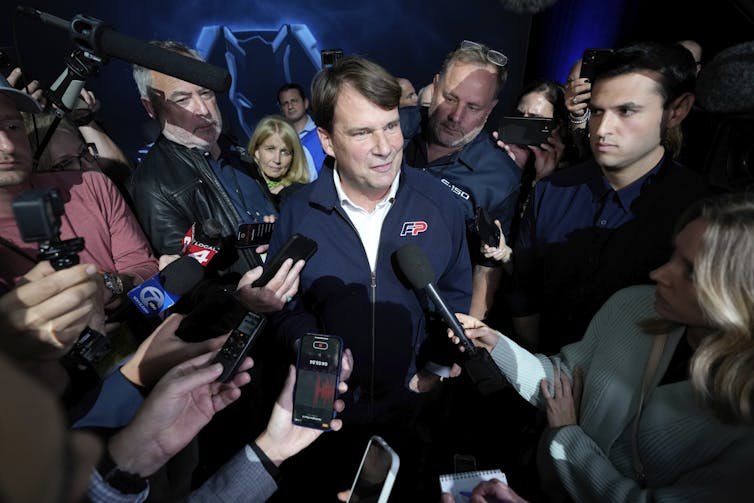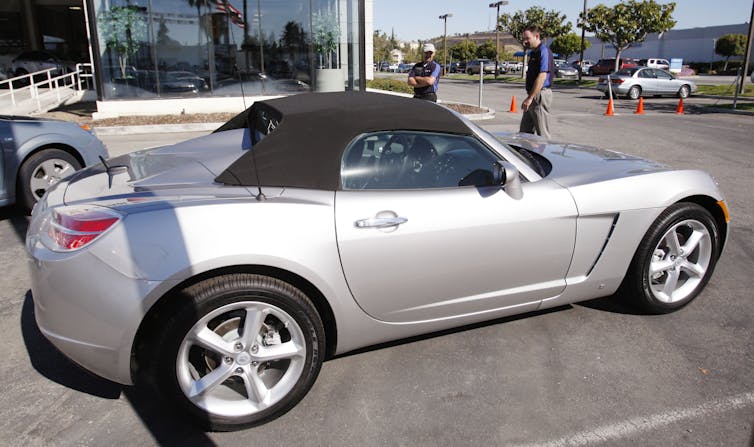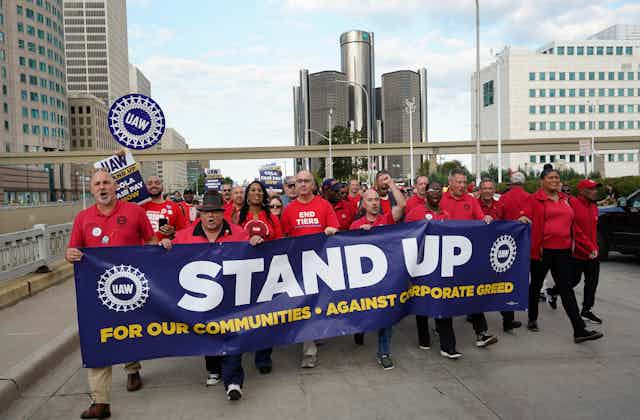The United Auto Workers union is ramping up its strike against General Motors and Stellantis – the global company that makes Chrysler, Jeep and Dodge vehicles – and getting closer to a deal with Ford.
About 5,600 UAW members at 38 General Motors and Stellantis distribution centers for auto parts in 20 states walked off the job on Sept. 22, 2023, after an announcement by UAW President Shawn Fain.
Workers at the only Ford plant affected by the strike since it began on Sept. 15 will remain off the job. The total number of UAW members involved in the strike stands at about 18,300.
Under Fain’s leadership, the union is taking an adversarial approach: It’s railing against what it describes as the “poverty wages” UAW members earn while denouncing the automakers’ CEOs as “greedy” and vowing to “wreck their economy.”
As a scholar of employment relations, I think this strike is too narrowly focused on making up for the wages and benefits autoworkers have lost in recent years. But another big objective is ensuring that autoworkers will have good jobs once most U.S.-made vehicles are electric-powered.
This dispute alone will not resolve this larger objective. Rather, I believe management and labor will need to swiftly move on following the strike and work together constructively to meet that goal.
UAW’s demands
The union is demanding an end to the concessions it made to the three companies during the financial crisis that began in 2007. Its members employed by Ford, GM and Stellantis have experienced a 19% decline in their wages, after accounting for inflation, since 2008.
The union also wants the automakers – sometimes called the Detroit Three – to abolish the tiered wage system, which pays new employees far less than more experienced workers, even for the same work. The UAW initially said it was seeking a wage increase of 40% over four years and the restoration of a cost-of-living allowance that would link wages to inflation.
In addition to these demands, the UAW wants defined-benefit pensions for all workers restored, company-paid health benefits for retirees reestablished and the right to strike over plant closures guaranteed. Other demands include more paid time off and seeing all temporary workers made permanent. It has also called for a 32-hour work week without a pay cut.

Precedents for working together
Although the strike has emphasized the goal of boosting future autoworker pay and benefits, I believe that workers and management can look to the past for ideas that might help them move forward.
GM’s Saturn partnership offers one potential model.
The company’s approach to its Saturn brand of compact vehicles, launched in 1985, was unique in many respects. Its governance structure was characterized by shared decision-making at different levels throughout the plant. The local union was a full partner in virtually all business decisions.
GM invested billions of dollars in this venture, through which it tried to compete with Japanese imports and transplants that were quickly eroding GM’s market share. Saturns were designed differently than other U.S. vehicles, but what made those vehicles special was the extent to which labor shared the responsibility for running Saturn’s main factory.
The Saturn partnership was hard to maintain, especially following the departure of Roger B. Smith, the General Motors CEO who had pushed hard for it. The company stopped making Saturns in 2009, but the former subsidiary’s overall approach of involving workers in decisions about their jobs and the manufacturing process remains as critical today as it was in its heyday.
I would encourage the auto industry to again invoke the spirit of the Saturn venture, which emphasized the collaboration and partnership of labor and management in the production of high-quality, world-class vehicles. Only this time, the vehicles will be EVs.

GM offers another model for positive union-management relations.
About 20 years ago, its Lansing-Grand River assembly plant in Michigan began to engage in a similar example of what I call joint responsibility unionism. Management and the local UAW union established a contractual commitment to work together to continually improve production by systematically solving problems and increasing productivity.
Management and the local UAW union established a contractual commitment to work together to continually improve production by systematically solving problems and increasing productivity.
The local union and management hold each other accountable for keeping costs down and quality high. The plant, which assembles Cadillacs and Chevy Camaros, continues this approach successfully today.
Shift the focus to the future
The UAW is pointing to the billions of dollars in profits auto companies are currently getting when it demands a bigger piece of the pie. The companies counter that rapidly increasing EV production is costly.
GM, Ford and Stellantis already plan to invest more than US$100 billion in electric vehicle manufacturing. As production shifts away from vehicles with internal combustion engines that burn gasoline or diesel fuel, the number of autoworkers needed to build them will decline. EVs have fewer parts.
Ford and Volkswagen, for example, have estimated that they’ll eventually need 30% less labor due to the EV transition.
Undergoing this transformation with labor and management at loggerheads can’t possibly benefit the UAW or the auto companies.
Instead, they’ll need to focus on finding solutions together that increase productivity, build a skilled workforce and efficiently convert plants that make conventional vehicles today to EV factories tomorrow. In so doing, the UAW is more likely to meet its goal of seeing those EV factories employ its members.

